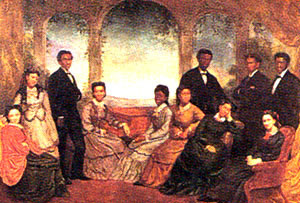
Jubilee Singers of Fisk University
In 1871, only four years after the incorporation of Fisk Free School as Fisk University in Nashville, the school for emancipated African Americans faced impending closure. Classrooms and living quarters continued to be housed in the decaying barracks of the Union army hospital, where leaking roofs and inadequate facilities posed a serious problem for the expanding student population. Fisk University clearly needed a larger and more suitable campus. To overcome this crisis, the school’s student choir embarked upon a series of fund-raising concert tours.
As early as 1867 university treasurer George White had developed an appreciation for the students’ a cappella singing and began organizing small choral groups. When White proposed a tour by a singing student troupe, he met opposition from the American Missionary Association, which sponsored the school. In 1871 the school’s financial crisis became so severe that the local university trustees decided–in what must have been a monumental decision at that time–to allow the students to undertake a northern musical tour without the support of the association. Students selected for the nine-member ensemble were Isaac Dickerson, Maggie Porter, Minnie Tate, Jennie Jackson, Benjamin Holmes, Thomas Rutling, Eliza Walker, Green Evans, and Ella Sheppard.
Following a successful southern concert tour in the fall of 1871, the troupe traveled through several northern states and New England. During that northern tour, the singers performed Negro spirituals as an encore to their concert of “mainstream” sacred songs. As a result of the enthusiastic response to the spirituals–or slave songs, as they were often called–a larger portion of each performance began to be devoted to spirituals, from which the singers derived their name. After a night of prayer and thanksgiving for the auspicious beginning of the singers’ tour, manager George White remembered the Biblical reference (Leviticus 25: 8-17) to the Hebrew “year of jubilee,” that marked the end of slavery. Realizing that the spiritual message of the singers reflected a similar jubilation or jubilee, he bestowed the name Jubilee Singers upon the Fisk students.
The success of the 1872 tour paid many of the school’s debts and provided for the purchase of a new campus in Nashville. The tour was also profitable in another way: the Jubilee Singers’ dignified, yet profoundly poignant, performances erased white misconceptions of African American education and culture and created new images of both. In addition, the Singers’ presentation of the Negro spiritual popularized the songs within a wider audience and aided in preservation of the songs for the historical record.
In 1873 the Jubilee Singers and George White boarded a ship for England for a successful British tour. Their numerous performances created a storm of approval and culminated in a performance for Queen Victoria.
The troupe triumphantly returned to Nashville in May 1874 with news that they had raised nearly fifty thousand dollars for Fisk University’s first permanent structure. The imposing Victorian Gothic six-story building, named in honor of the Jubilee Singers, was dedicated on January 1, 1876. A floor-to-ceiling portrait of the Jubilee Singers, which has become a universally recognized symbol of the spirit of Fisk University, hangs in Jubilee Hall.
The contributions of the original nine Jubilee Singers and their successors to the growth of the university and the establishment of the spiritual as an authentic musical expression are immeasurable. The young singers proved themselves intelligent, accomplished, well-rounded people, completely competent to assist their school and themselves. They totally confounded critics who questioned the fitness of African Americans for education, especially higher education.
Suggested Reading
Reavis L. Mitchell Jr., Fisk University Since 1866: Thy Loyal Children Make Their Way (1995)



